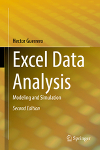- About MAA
- Membership
- MAA Publications
- Periodicals
- Blogs
- MAA Book Series
- MAA Press (an imprint of the AMS)
- MAA Notes
- MAA Reviews
- Mathematical Communication
- Information for Libraries
- Author Resources
- Advertise with MAA
- Meetings
- Competitions
- Programs
- Communities
- MAA Sections
- SIGMAA
- MAA Connect
- Students
- MAA Awards
- Awards Booklets
- Writing Awards
- Teaching Awards
- Service Awards
- Research Awards
- Lecture Awards
- Putnam Competition Individual and Team Winners
- D. E. Shaw Group AMC 8 Awards & Certificates
- Maryam Mirzakhani AMC 10 A Awards & Certificates
- Two Sigma AMC 10 B Awards & Certificates
- Jane Street AMC 12 A Awards & Certificates
- Akamai AMC 12 B Awards & Certificates
- High School Teachers
- News
You are here
Excel Data Analysis

Publisher:
Springer
Publication Date:
2018
Number of Pages:
346
Format:
Hardcover
Edition:
Second Edition
Price:
84.99
ISBN:
978-3-030-01279-3
Category:
Textbook
[Reviewed by , on ]
Robert W. Hayden
04/22/2019
A review of this book should begin with a review of the title. In the 1950s "data analysis" had no special meaning, and if one threatened to do some, one would probably be expected to try to analyze some (probably numerical) data. In the 1960s, John Tukey developed ideas he described with the title "exploratory data analysis" (EDA). Before then the discipline of statistics had been concerned primarily with analyzing data from carefully designed studies aimed at answering specific questions. Tukey looked at "found" data and explored it for unanticipated patterns. He also developed many tools for exploring such data by eye or by hand. These were valuable contributions, to the unfortunate extent of becoming a bit of a fad. Soon every introductory statistics textbook felt the need to work "data analysis" into its title. It is telling that the word "exploratory" was dropped, as indeed these texts included only the simplest of Tukey's techniques, and did little or no exploring with them. (For example, a homework exercise in which the student was given a moderately complex data set and asked to explore it and report their findings was exceedingly rare.) More recently, data analysis has morphed into "data science." This revives Tukey's exploratory outlook, but applies it to much larger bodies of data, for which automated techniques are more appropriate than analysis by hand or by eye.
So where does the book at hand fit in? In the 1950s. There is no sign of EDA or data science. The title might well be translated as "some small business applications of Excel." Taken in that light, it has some noteworthy strengths and some disturbing weaknesses.
The book is not about such fields as statistics or simulation, though it offers some coverage of those topics. Nor is it an Excel manual. Instead, it introduces a variety of business scenarios, discusses how to approach those, and implements the proposed solution with Excel. There is a hidden limitation here in that this limits the problems to ones Excel claims to handle. These scenarios appear to be fictitious, but they are simplified examples of real business problems and should convince students that they are learning useful business skills. The Excel instructions are brief, but there is a strong emphasis on good spreadsheet design and practices. For example, most Excel graph types are more for decoration than analysis, and the author wisely suggests avoiding the merely decorative. The chapter on categorical data is really excellent and would make a good supplement to an introductory statistics course. There we usually encounter such data already summarized in a table, while in the real world (and examples in this text) we start with raw data and the main task is to decide what table to make and to figure out how to get it made.
The weaknesses, or at least the ones apparent to your reviewer, are in statistics, which gets a chapter of its own as well as additional scattered examples. There can be found too many mistakes and misconceptions to list here. A systematic problem in the statistics chapter (on inference) is that in no case is any sort of display made of the data being analyzed. The assumptions underlying the methods get very spotty coverage, with no tools (such as plotting the data) suggested for checking whether the assumptions are met. While there is reasonable coverage of random sampling and assignment, and observational studies are mentioned in passing, there is no recognition that data from random samples or controlled experiments would be very rare in most small business applications. "Random sample" is not defined, nor much guidance given to taking one, so the reader may well be left with the impression that the happenstance data so common in business records qualifies.
So, to whom, if anyone, can this book be recommended? Thinking first of MAA members, it is hard to imagine a course one might be teaching for which this would be a reasonable supplement, let alone a text. It could be useful to a faculty member or student who wished to learn Excel through a number of business applications, but they would best skip the chapter on inferential statistics. For such an audience the writing is very clear and no special knowledge of business is required. The book offers a modest number of exercises (generally good) but no index.
After a few years in industry, Robert W. Hayden (bob@statland.org) taught mathematics at colleges and universities for 32 years and statistics for 20 years. In 2005 he retired from full-time classroom work.
See the publisher's page.
- Log in to post comments




